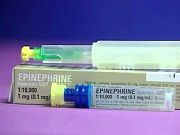Early Epinephrine Treatment in Anaphylaxis Associated with Reduced Risk of Hospitalization
New research indicates that children who receive epinephrine injections before they go to the emergency room for food-related anaphylaxis are less than half as likely to require hospitalization as those who first receive such treatment at the hospital.

New research indicates that children who receive epinephrine injections before they go to the emergency room for food-related anaphylaxis are less than half as likely to require hospitalization as those who first receive such treatment at the hospital.
Researchers reviewed the records of 384 patients who presented with food-induced anaphylaxis at a large pediatric emergency department over a 6-year period. That study cohort was evenly divided between boys and girls, and the median patient age was 5.2 years.
All major guidelines for anaphylaxis care recommend epinephrine injections as the key treatment for virtually every victim, but only 234 of the patients (61%) received epinephrine at any point in their treatment.
Among those who got epinephrine, 164 (70%) received at least one injection before they reached the emergency room, while the remaining 70 (30%) received their first dose in the hospital.
Pretreated patients required less treatment once they arrived at the emergency room. They received significantly fewer antihistamines, steroids, and inhaled medications.
Pretreatment was also associated with a dramatically lower rate of hospitalization. Only 17% of pretreated patients were admitted to the facility. The rate for patients who did not receive early epinephrine was 43% (P < .001).
The relationship remained significant even after researchers adjusted for age, sex, and race. Pretreatment was strongly associated with a reduced risk of hospitalization (odds ratio 0.25; 95% confidence interval, 0.12-0.49).
In addition to providing more evidence in support of early epinephrine use, the study, which was published in The Journal of Allergy and Clinical Immunology: In Practice, also identified several factors that were significantly associated with early usage.
Patients who received early epinephrine treatment were older than those who did not (7.4 vs. 4.3 years; P=.008). Roughly 66% of kids who received early treatment had a known food allergy compared to only 34% of those who received treatment later (P<.001).
The most significant factor, however, was ownership of an epinephrine autoinjector. Only 23% of those who did not receive early treatment had such a device, while 80% of all kids who received early treatment owned at least one (P < .001).
Such figures, the study authors concluded, suggest that increasing access to epinephrine autoinjectors may be the single most important factor in reducing hospitalizations stemming from food-induced anaphylaxis.
The findings also suggest the need to provide effective education, both to medical professionals and other potential first responders such as parents and school staff.
The number of children who received no epinephrine before or during their time in the emergency room suggests some need for better training, but the emergency room in this study actually performed better than many others.
One survey of 34 EDs found that only 19% of patients with food-related allergic events received epinephrine as part of treatment. Another found that only 13% of patients received it for events triggered by stings.
On the school front, efforts are underway in districts across the country to prepare staff for allergic reactions. The number of schools that are stocked with autoinjectors has increased, though recent studies have found there’s still much room for improvement.